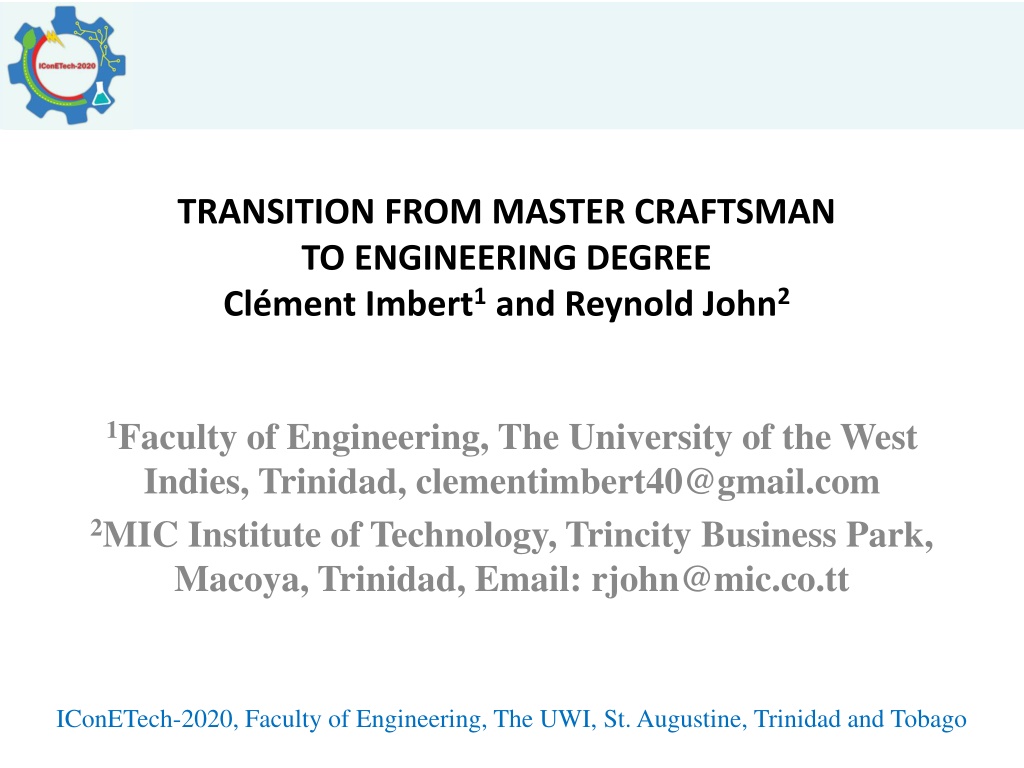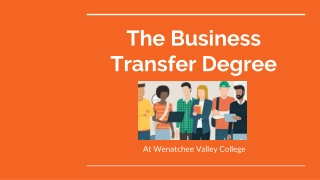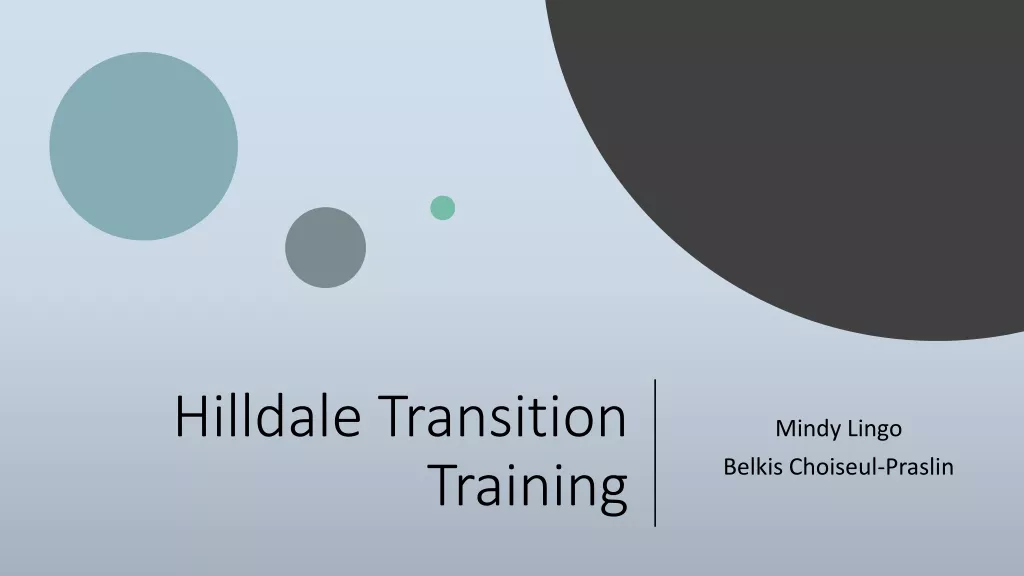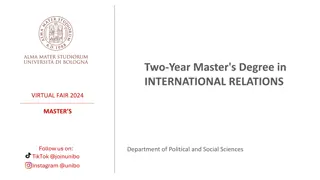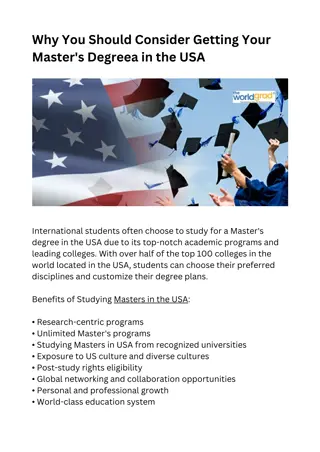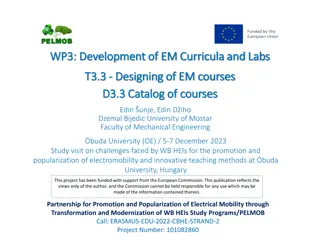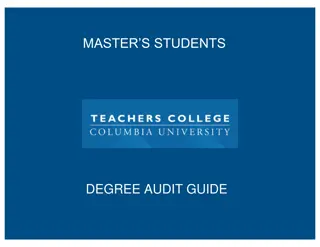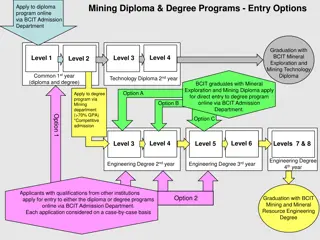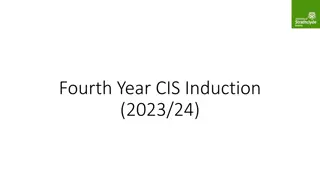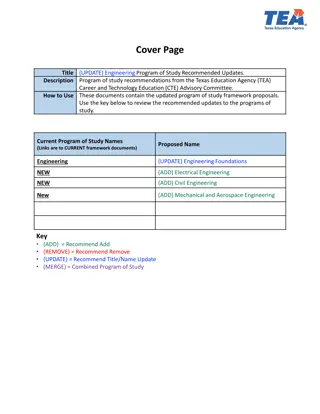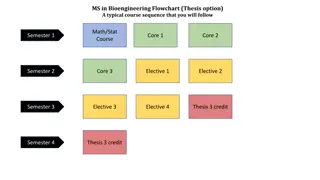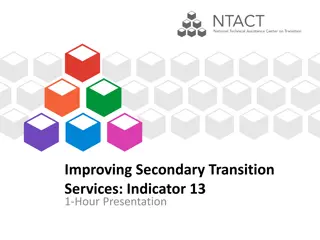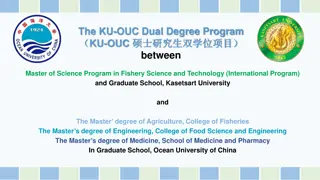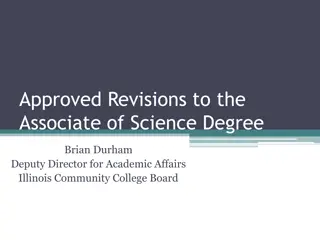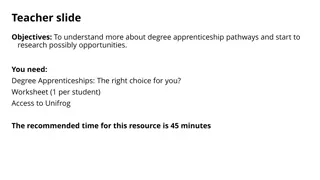Transition from Master Craftsman to Engineering Degree
Learn about the transition from a Master Craftsman to an engineering degree, including the significance of the Meister qualification in Germany, the objectives of the Dual Meister/Bachelor program, and the process of becoming a Journeyman and Master-Craftsman. This journey offers valuable practical skills, theoretical knowledge, and business opportunities, contributing to the development of a well-rounded professional.
Download Presentation

Please find below an Image/Link to download the presentation.
The content on the website is provided AS IS for your information and personal use only. It may not be sold, licensed, or shared on other websites without obtaining consent from the author.If you encounter any issues during the download, it is possible that the publisher has removed the file from their server.
You are allowed to download the files provided on this website for personal or commercial use, subject to the condition that they are used lawfully. All files are the property of their respective owners.
The content on the website is provided AS IS for your information and personal use only. It may not be sold, licensed, or shared on other websites without obtaining consent from the author.
E N D
Presentation Transcript
TRANSITION FROM MASTER CRAFTSMAN TO ENGINEERING DEGREE Cl ment Imbert1 and Reynold John2 1Faculty of Engineering, The University of the West Indies, Trinidad, clementimbert40@gmail.com 2MIC Institute of Technology, Trincity Business Park, Macoya, Trinidad, Email: rjohn@mic.co.tt IConETech-2020, Faculty of Engineering, The UWI, St. Augustine, Trinidad and Tobago
INTRODUCTION The Meister is the highest qualification in TVET in Germany The Meister is on the same level as a Bachelor's degree in the German Qualifications Framework Only a Meister is allowed to run certain businesses in Germany Includes theoretical, practical, business and pedagogical training The Meister (Master-Craftsman) has been offered at MIC-IT in the following area, but not every year it depends on demand: - Automotive Eng. Tech. - Construction Eng. Tech. - Electrical Eng. Tech. - Mechanical Eng. Tech. - Mechatronics - Photovoltaics Accredited by the German Chamber of Crafts and Trades Advanced admission recommended for BTech IConETech-2020, Faculty of Engineering, The UWI, St. Augustine, Trinidad and Tobago
OBJECTIVES The Dual Meister/Bachelor outcomes are expected to be: i. Increase of relevance, quality and competencies and in the Master-Craftsman programme and the Bachelor s degree ii. Transfer of relevant professional skills and practical experience through the dual study approach iii. Important contributions to overcoming the shortage of entrepreneurs in SMEs iv. Bologna-compliant study, full international recognition v. Contribution to the EU agenda for the modernization of Europe s higher education systems; vi. Creation of permeability and reduce recognition problems vii. Increase in attractiveness of TVET IConETech-2020, Faculty of Engineering, The UWI, St. Augustine, Trinidad and Tobago
JOURNEYMAN The Master-Craftsman qualification is done in two steps, the 1st being the Journeyman, the 2nd being the Master-Craftsman TheJourneyman programme takes 3 Years full-time Entrance qualification - 3 CSEC subjects (English, Math, Science) 1st Year Trainees are exposed to electrical engineering technology, mechanical engineering technology including workshop technology, welding and industrial maintenance 2nd and 3rd Year trainees have to select one occupational area in which to specialize Trainees are placed in industry on attachment and return to classes one day per week during the 2nd year and two days per week during the 3rd year IConETech-2020, Faculty of Engineering, The UWI, St. Augustine, Trinidad and Tobago
MASTER-CRAFTSMAN The Master-Craftsman programme, takes ten months after having successfully completed the Journeyman programme. The programme takes place 40% in the training institution and 60% as internships in industry. Many MIC-IT trainees have had four months of the ten months conducted in Germany (including industrial training). The examination includes theoretical, practical and oral components and may take up to a week . In some disciplines the creation of a masterpiece, for example workshop technology, is also part of the examination process. Until 2004 German regulations required working experience of 3 years as a Journeyman before taking the Meister examinations. IConETech-2020, Faculty of Engineering, The UWI, St. Augustine, Trinidad and Tobago
METHODOLOGY The MIC Institute of Technology (MIC-IT) plans to implement the Dual Bachelor/Meister (Master-Craftsman) Programme MIC-IT s plans re mapping the comparisons between the Master-Craftsman and Bachelor of Technology programmes Observe and cognize the similarities and differences Implement what needs to be acquired to facilitate articulation of the Master-Craftsman to the Bachelor s Degree Fusion of the very practical Master-Craftsman and more theoretical Bachelor s degree IConETech-2020, Faculty of Engineering, The UWI, St. Augustine, Trinidad and Tobago
RESULTS The MIC Institute of Technology has started mapping the Master-Craftsman curricula in Construction, Mechanical and Electrical/Electronic Engineering Technology and Mechatronics against several comparable degree programmes. Functional Maps are also being developed for each area of concentration and course specific content to generate appropriate course outcomes and gaps A cursory examination of the mapping so far has revealed that the major differences are in the level of mathematics and certain broader aspects of the training of an engineer including the so-called soft skills. IConETech-2020, Faculty of Engineering, The UWI, St. Augustine, Trinidad and Tobago
CONCLUSIONS In several countries students are streamed after the early years in secondary school, so that more academically-accomplished students tend to pursue the classical Bachelor of Science Engineering degree. The other students tend to pursue TVET. The Master-Craftsman Programme creates individuals with extensive practical knowledge, experience and pedagogy. The Master-Craftsman qualification has some challenges regarding its attractiveness, compared to a Bachelor s degree. The Bachelor s Degree lacks a significant proportion of the above specific competencies but includes more theory. The combination would play a critical role in developing a holistic individual for the advancement of the practice of engineering. IConETech-2020, Faculty of Engineering, The UWI, St. Augustine, Trinidad and Tobago
CONCLUSIONS (Contd) Skillful mapping of both programmes would allow the Master- Craftsman advanced admission in a BTech programme. It is very important to grant Master-Craftsmen the opportunity to enhance their qualifications and professional status. This would undoubtedly bring some parity of esteem between TVET and so-called Academics. This opportunity would encourage accomplished students to pursue TVET followed by a BSc. The dual qualification system is particularly important for Trinidad and Tobago, where TVET is not accorded the respect (and remuneration) that such hands-on training and qualifications require in order to advance the economic development of the country in all areas of technology. UK introduction of T Levels may be sign of things to come. UK universities may have to consider an articulated BTech. IConETech-2020, Faculty of Engineering, The UWI, St. Augustine, Trinidad and Tobago more academically-
REFERENCES 1. ttps://www.anerkennung-in- utschland.de/html/en/german_confederation_of_skilled_crafts.php 2. https://en.wikipedia.org/wiki/Trade_and_crafts_code_of_Germany 3. https://en.wikipedia.org/wiki/National_Vocational_Qualification 4. "Der Deutsche Qualifikationsrahmen f r Lebenslanges Lernen". bmbf.de. (German Federal Ministry of Education and Research Bulletin, 16 May 2013) 5. www.mic.co.tt 6. https://www.utech.edu.jm/about-utech 7. www.bachelor-meister.eu/ 8. http://ec.europa.eu/education/erasmus/history_en.htm 9. www.bachelor-meister.eu/ 10. https://en.wikipedia.org/wiki/Bologna_Process IConETech-2020, Faculty of Engineering, The UWI, St. Augustine, Trinidad and Tobago
REFERENCES (Contd) 11. The Bologna Accord: A European Revolution with Global Implications , The Newsletter of the Graduate Management Admission Council, January-February, 2005 12. https://en.wikipedia.org/wiki/Abitur 13. Education Secretary announces first new T Levels Department for Education. October 22, 2017 14. Guidance - - Introduction of T Levels, Department for Education, UK, October 7, 2019 15. Pupils who take government s technical qualifications could miss out on top universities, experts warn . Article in the Independent, UK, by Eleanor Busby, Education Correspondent, December 10, 2019 IConETech-2020, Faculty of Engineering, The UWI, St. Augustine, Trinidad and Tobago IConETech-2020, Faculty of Engineering, The UWI, St. Augustine, Trinidad and Tobago
THANK YOU! IConETech-2020, Faculty of Engineering, The UWI, St. Augustine, Trinidad and Tobago
